Zotz Trip Report: La Madriguera de los Lobos - Updated September, 2013
INTO THE WOLVES' LAIR
 April 6, 2006.
Sergi and I took our SpeleoBug to La Taberna and hiked up to Tequilizinta
Bluff. We were surprised to see the Santiago River filled with four times more
water than usual and to hear the roar of rapids for the first time. Even more
surprising was the color of the river: a bright green that looked like it had
spilled right out of a paint can.
April 6, 2006.
Sergi and I took our SpeleoBug to La Taberna and hiked up to Tequilizinta
Bluff. We were surprised to see the Santiago River filled with four times more
water than usual and to hear the roar of rapids for the first time. Even more
surprising was the color of the river: a bright green that looked like it had
spilled right out of a paint can.
Our plan was to check out all the holes in Tequilizinta Bluff to see if we could
find another cave as interesting as La Cueva Cuata. We began at the south end of
the cliff wall. The first hole we found was just a “pinche socavón” too small to
even qualify as a shelter cave...
...However, looking at the breakdown that had
fallen out of this hole, we were amazed to discover a chunk of volcanic rock
about 50X60 cm, one side of which was completely covered with the biggest lava
stalactites so far seen in Jalisco.
|
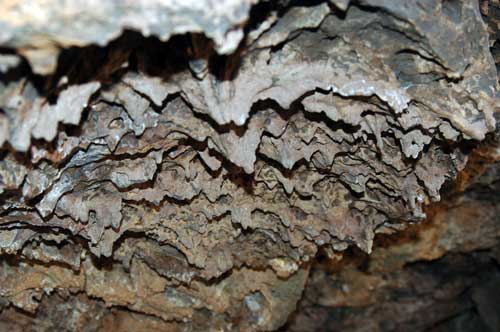 |
| ...Hole number two was about 6x12 m and had bats in the back....
|
 |
Hole number three was only 5 m deep but had a man-made wall across the entrance,
suggesting it had once been used as a shelter cave or animal pen.
| The next hole wasn’t even worth mentioning, but Hole 5 turned out to be very
interesting indeed. This one require a climb of several meters up a pile of
breakdown at the top of which, Sergio found what he described as a “chorro de
diarrhea.” This, in reality, is a large (maybe 50 cm high and wide) lava
stalagmite created when “ropes” of lava were squeezed from the cliff wall. The
Diarrhea Discharge was definitely produced by a flow of lava, strengthening our
conviction that Cueva Cuata is a lava tube.
|
 |
| ... A few meters north of this
formation, there’s a small cave inside of which we found two baby birds. Each
so-called baby was the size of a large turkey and they looked like big, round
balls of fluffy yellow down. Only their hooked black beaks gave them away as
baby buzzards. Well, actually the faint odor of rotting meat told us these
youngsters were not living on crickets and worms.
|
 |
The next hole is the opening directly below Cuata Cave… a seven-meter-wide
opening which we had never investigated because we had always been interested in
the cave above.
|
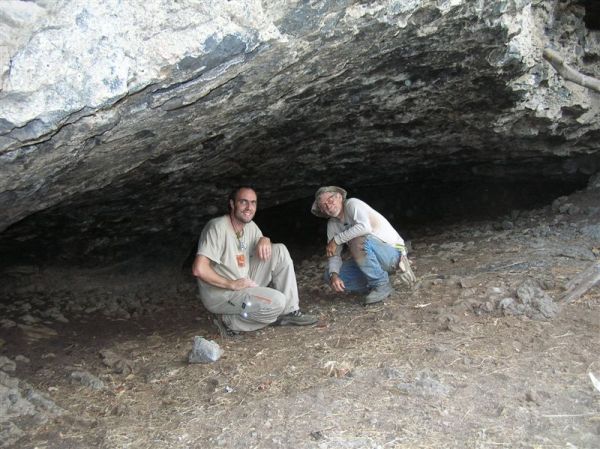 |
|
A glance inside showed us that this hole goes back a long way, so we broke out
the survey equipment and Sergi put on his boiler suit. The first thing we
noticed about this cave was a number of flat layers of rock on the floor which
might actually be several coats of lava.
|
 |
...Here and there were clusters of
yellowish-orange stalactites (none longer than 2 cm) which appeared to be of
calcite deposited after leakage of water through the roof. This was not
surprising as we were directly beneath Cueva Cuata which has several pools of
water.
|
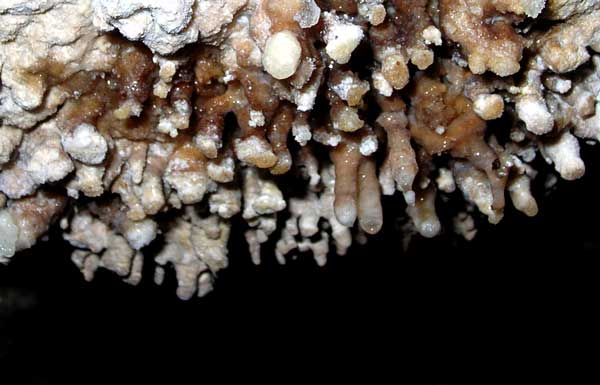 |
| ...This was one of those caves not quite high enough for you to duck-walk. Like
Cuata Cave it would divide into two passages which soon joined back together.
The entire floor of the cave is covered with powdery dust and it’s impossible to
move around without stirring it up because “moving” means either crawling on
your hands and knees or sliding sideways.
Sergi
demonstrates the typical position required for surveying.
|
 |
|
About 60 meters inside, we came upon
a lot of very dry and old-looking “coprolites” which greatly resemble (both in form and
size) the wolf scat we had observed in Saudi Arabia’s caves. Of course, we had
no way to tell whether this might be from coyotes or some sort of wolf that may
have inhabited the area a long time ago. If we had a source of funding, it would
be interesting to carbon date these droppings.
Wolf or coyote?
If you know, tell us!
|
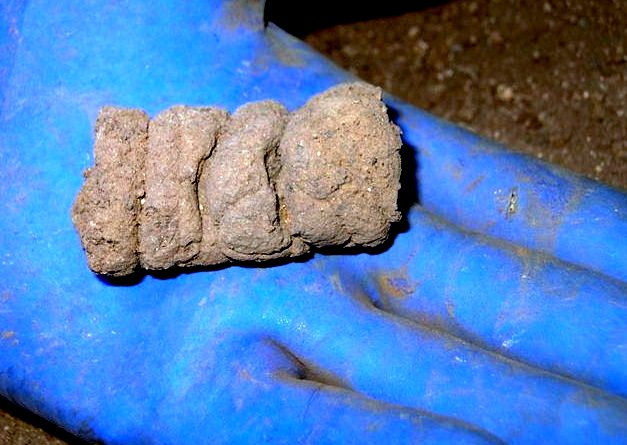 |
About 80 m from the entrance, we
reached the back end of the cave. The roof rose, but large chunks of breakdown
were piled right up to the ceiling. Bats were flying in and out of spaces in
these loose rocks and an airflow was noticeable, suggesting that the cave may
continue. However, the bats’ route looked rather unstable and I convinced Sergi
we should call it a day at this point...
|
And we did
produce a map of Madriguera de los Lobos Cave, one of the only two lava
tubes we have so far found in Jalisco. To see the full map, just click
on the detail shown here.
|
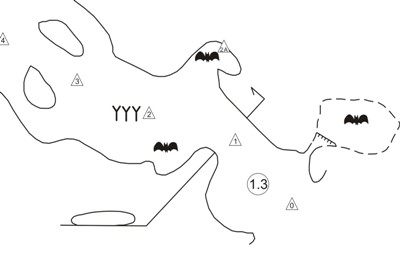 |
When we got back to La Taberna, where we had left the Vocho, we had a chat with
the man who lives next door to the distillery where we always park. He told us
about several other caves in the area. One, he said, is called El Tecolote, a
hole from which hot, humid air rises. Another is located near Campamento Santa
Rosa and there’s yet another one right next to the highway near La Conchilla, a
cave “with a low crawl at the back which then opens up into a big passage that
goes and goes.” This last one, called La Cueva del Muro, sounded like the most
interesting and the easiest to locate and we decided it was worth checking out.
A few weeks later Sergi and I drove to the Muro or supporting wall (after which
the cave is named), located on the cobblestone road to Santa Rosa. We stood at
the roadside looking over the edge of a very steep, garbage strewn slope. Just
then along came a local boy who
-
repeated the story about the cave continuing
after the low crawl and
-
told us there was a path down to it from a nearby
house.
We then went to the house where we found two little girls who didn’t even
know they had a cave in their back yard. Next, we invaded their banana orchard
and ended up on a “path” barely wide enough for a lizard to negotiate. At the
peril of our lives, we finally got down to the cave, which, indeed had a low
crawl in the back. Beyond the crawlway, however, was a tiny room that went
absolutely nowhere. As the total length of the cave was only about 10 m, we
forgot about surveying it and took pictures of a little waterfall in a nearby
stream. Seen from the bottom, the garbage-strewn slope didn’t look so bad and we
climbed straight up to the car.
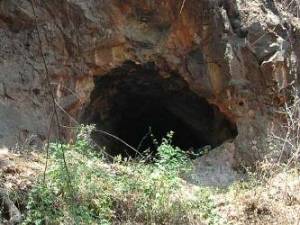 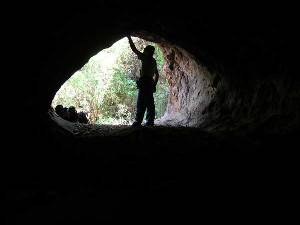 La
Cueva del Muro La
Cueva del MuroThe best
thing about it is the entrance
which you can see here from
both the outside and the inside. |
Finally, we drove down to the Santiago River where a boatman told us the river
had turned bright green due to the stirring up of algae in the dam. He also
spoke of yet another cave, just a few hundred meters downstream (only reachable
by boat, of course). This was also reputed to be “big” but we figured if the
boat capsized, we would both be dissolved by toxic wastes in the horribly
polluted river. We decided we’d leave this “hot lead” for Luis Rojas to check
out, as he appears to have been blessed with far more than nine lives.
John Pint
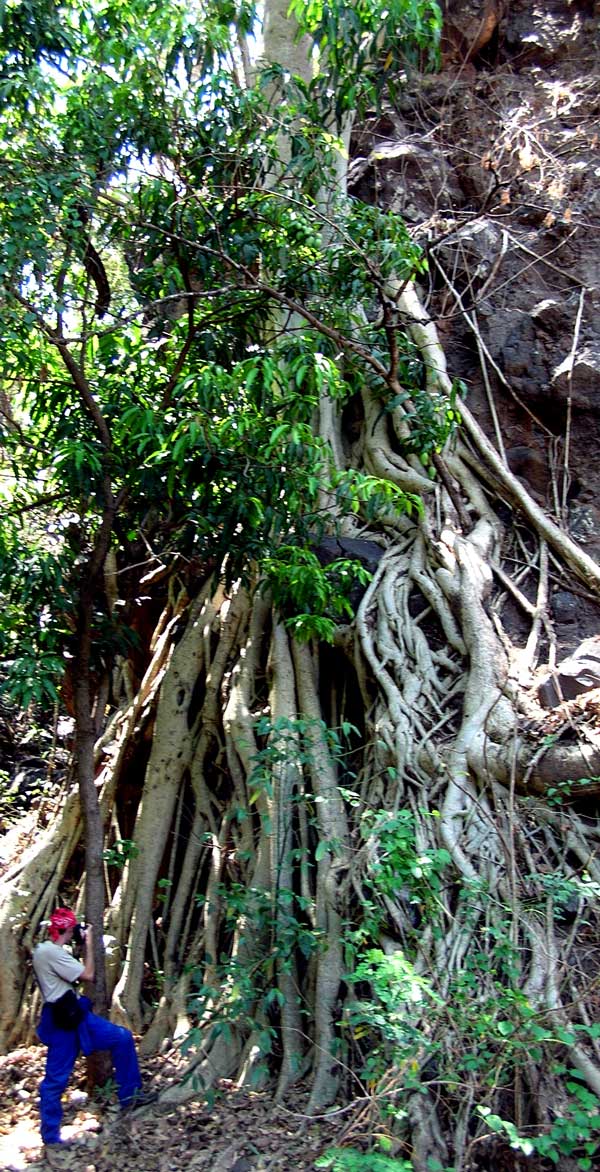
Sergi is more interested in this sprawling amate (Ficus
petiolaris) than in Muro Cave.

John Pint in the mouth of the Wolves' Lair
 April 6, 2006.
Sergi and I took our SpeleoBug to La Taberna and hiked up to Tequilizinta
Bluff. We were surprised to see the Santiago River filled with four times more
water than usual and to hear the roar of rapids for the first time. Even more
surprising was the color of the river: a bright green that looked like it had
spilled right out of a paint can.
April 6, 2006.
Sergi and I took our SpeleoBug to La Taberna and hiked up to Tequilizinta
Bluff. We were surprised to see the Santiago River filled with four times more
water than usual and to hear the roar of rapids for the first time. Even more
surprising was the color of the river: a bright green that looked like it had
spilled right out of a paint can.










 La
Cueva del Muro
La
Cueva del Muro
